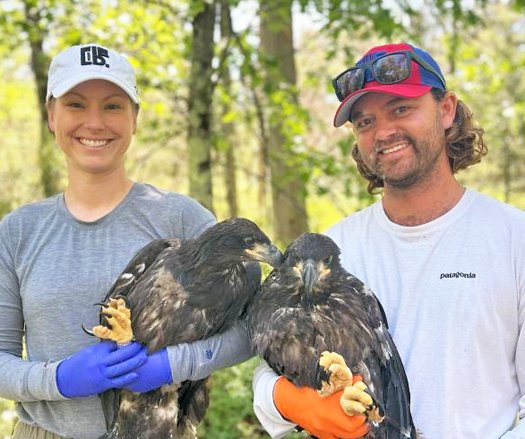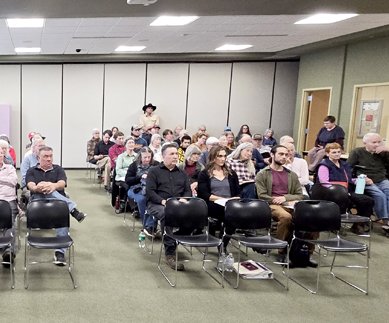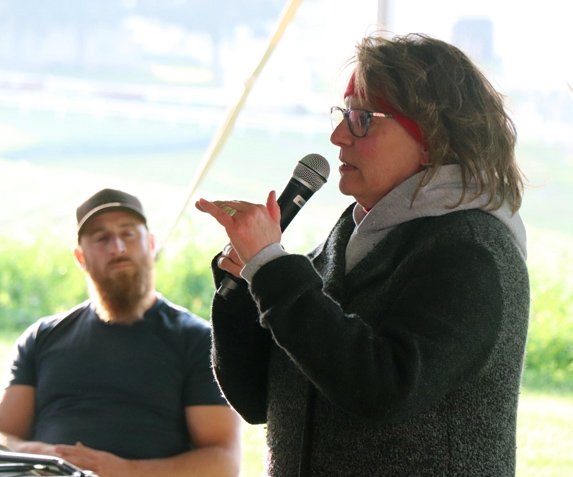The issue of the suitability for siting of a landfill on the underlying karst bedrock under the Vernon County Landfill is increasingly creating barriers to the county’s proposed expansion of the facility. While some, including county board members and the board’s retained hydrogeologist, dispute the site is underlain by karst, Wisconsin DNR has reserved judgment pending further investigations.
Karst geology is the study of landscapes formed by the dissolution of soluble rocks, typically limestone, by water, leading to the formation of features like sinkholes, caves, and underground rivers. This process creates unique landforms and affects water flow and underground storage, allowing for comparatively rapid infiltration of contaminants from the surface into underlying groundwater aquifers.
The Vernon County Board of Supervisors will take up the challenges with their expansion application at their Tuesday, April 15 meeting. On the agenda for approval is a resolution asking the county’s state representatives to intervene with DNR regarding what some on the board view as their unreasonable requirements to demonstrate feasibility of the site. More on that in an upcoming issue.
History of expansion
The initiative to expand the current landfill, located on the northeast side of the City of Viroqua in the Town of Viroqua, began in October of 2023, when the Vernon County Board of Supervisors voted 14-3 to pursue the expansion. While the initiative enjoyed significant support from townships throughout the county, the Town of Viroqua and many other citizens spoke in opposition.
Working with the engineering firm SEH, the county submitted their application for expansion to the DNR in 2023. In response, they received a ‘notice of incompleteness’ from DNR on December 19, 2023, asking for further investigation of the groundwater flow beneath the site and other questions. The issue was to determine whether the landfill had potential to leach hazardous substances into the aquifer that supplies drinking water for local residents, and which ultimately connects to the surface water system in the Seasbranch Tributary of the Kickapoo River. That tributary is a known refuge for native brook trout, which rely on cold, clean water.
Financial outlays
The county originally spent $950,000 to generate a 3,000-page feasibility study which was submitted to the DNR) Waste and Materials Management Program. Then, in early 2024, the board appropriated another $300,000 for a ‘Plan of Development.’
The board then dedicated an additional $750,000 for more DNR-required investigations, including rotosonic drilling of additional monitoring wells, to satisfy DNR’s questions in the first ‘notice of incompleteness.’ Expenditure of these funds is currently ongoing.
Then, in March of 2025, the county received a second, ‘notice of incompleteness’ from the DNR that was unanticipated by SEH. The agency continues to question the hydrogeologic conclusions about the suitability of the site for a landfill put forth by SEH hydrogeologist Melanie Niday, and warns that if their questions cannot be answered, DNR may see the need for an Environmental Impact Study (EIS) for the project.
Were this to happen, it could obligate the county to expenditure of another $300,000 to $400,00, with no guarantee the process would reach a favorable conclusion supporting their expansion application.
All of these expenditures come in the context of ongoing financial operational challenges for the landfill enterprise business, with reduced volumes undershooting budgeted projections, and competition from other landfills accepting waste in the area regarding tipping fees.
Town agreement
Another challenge the county is facing in their expansion application is negotiating a siting agreement with the Town of Viroqua, which has empanelled a Siting Committee to negotiate with the county.
The town has retained attorney Anders Helquist of the Weld Riley Law Firm of Eau Claire to represent them in the process. Helquist numbers among his accomplishments a successful negotiation between Eau Claire and a landfill owned by Canadian firm GFL, representing the municipality. In recent years, Southwest Sanitation was purchased by GFL, and is one of the options for where Vernon County could send their waste if their expansion application is unsuccessful.
At a joint meeting of the Vernon County Board Infrastructure Committee and the Town of Viroqua Siting Committee, held on Wednesday, April 9, Helquist presented committee members with the town’s proposed siting agreement.
Members of the Town of Viroqua Siting Committee include supervisor AnnaJo Doerr, Kathleen Crittenden, Rice Spann, and Dennis Brault. Members of the Infrastructure Committee present for the meeting included county board chairman Lorn Goede, and supervisors Martha Olson and Charles Jacobson. Landfill Manager Stacey Sanborn was also present.
“The good news is I’m not going to go through this 60-page agreement with you line-by-line,” Helquist told the committee. “Instead, I’m going to take you through the highlights.”
Helquist made clear that the town Siting Committee can negotiate with the county regarding landfill operation and town compensation for siting the landfill in their municipality.
“The siting agreement between the town and county is intended to create a binding, written agreement about landfill operations and compensation,” Helquist said. “To be clear, the town host committee does not have a vote on whether the landfill is permitted.”
Operational topics
The first operational topic highlighted by Helquist involves access to the landfill. The town is asking that town roads not be used by haulers for ingress or egress from the facility. Instead, the proposed agreement would require that only Highway 14/61, County Y, and County LF would be used to access the landfill.
“Who will enforce that?” Sanborn asked.
“It would be the county’s responsibility to regulate and police trucking routes in and out of the landfill,” Helquist responded.
The next issue raised by Helquist was litter from the landfill along roads.
“The town proposes that the county monitor the stretch of County LF to County Y, and one mile east onto Asbury Road, and pick up any litter resulting from landfill operation on a regular and continuing basis, no less than once per week,” Helquist said.
The third issue from the proposed agreement highlighted by Helquist pertains to hours of operation. The agreement would limit hours for accepting waste to 7:30 a.m. to 3:30 p.m., Monday through Friday, with additional operations relating to covering of deposited waste authorized to continue until 5 p.m.
The fourth issue Helquist brought forward is controlling dust and blowing debris from the facility, and taking steps to mitigate odors from the facility.
“The proposed operational requirements are intended to ensure that dust and debris is not blowing off the facility, and that steps are taken to mitigate the odor from the facility,” Helquist explained. “DNR has already cited the county for garbage that is exposed and not covered.”
Well testing
Perhaps the most stringent operational measures proposed by the town pertain to ongoing monitoring of groundwater and surface water in proximity to the facility.
“The town asks that the county undertake groundwater monitoring as required by DNR, and in addition, monitoring of private well water quality for residents in the area,” Helquist said. “To be discussed would be the frequency of monitoring of well water, and what substances would be tested for.”
Helquist specified that the town is interested in monitoring for PFAS, heavy metals, and other contaminants that are emerging as substances of concern based on data from the monitoring wells required by DNR, both past and present.
“In the event contamination of wells is discovered, then the county will provide affected residents with potable water,” Helquist explained. “If investigation determines the contamination is tied to the landfill, then the county will provide a permanent source of potable water for private residences or agricultural operators affected.”
Helquist detailed that the town is taking the vulnerability of the aquifers that supply drinking water, given the areas underlying karst bedrock, very seriously. He pointed out that the DNR is also taking the issue very seriously, based on the questions posed by them in their second notice of incompleteness, received by the county the prior week.
Earlier, Viroqua resident KJ Jacobson had provided public input to the county committee based on her analysis of monitoring well data from the wells required by DNR.
“We need to protect groundwater, and data from the monitoring wells at the site reveal that volatile organic compounds (VOCs) have been leaking through the intact membrane since 1990,” Jacobson asserted. “In addition, contamination from the special waste soil from demolition of the old county highway building used for cover at the site, which is petroleum impacted, has now showed up in monitoring well #19. “This is very serious, and the DNR is not going to protect our aquifer until it’s too late,” said Jacobson. “They think you clean up an aquifer. Well, there are aquifers on the east side of the state that are surficial and close to the surface, and they can be cleaned up, but ours can’t.”
Jacobson urged the county to stop receiving food waste, conduct heavy metal detection sampling (at present, only undertaken immediately after a monitoring well is installed), respond to any problematic test results with immediate re-testing, test for PFAS, conduct quarterly monitoring where tests reveal problematic results, including acquisition of cutting edge equipment, and conduct additional monitoring when precipitation increases the amount of leachate as it can drive elevated permeation.”
Surface water
“In addition, the town is asking for semi-annual monitoring of surface water quality in Seasbranch Creek for the current substances required by DNR, and also for TKN, ammonia nitrogen, PFOA, PFOS, and any other substances that may later be required by DNR,” Helquist detailed.
Helquist informed the county that the town is hiring a hydrogeologist to assess the landfill site. The hydrogeologist will assess the site for stability and the potential to contaminate groundwater.
“Results of this assessment may result in the town becoming more involved in the landfill design process with DNR,” Helquist said. “This could mean that the county is required to maintain a contingency fund to protect the health and safety of local residents.”
More issues
Regarding the issue of compensation to the town for the siting of the landfill in their jurisdiction, the Siting Committee has proposed that the county pay the town $3/ton plus an annual consumer price index adjustment. Not included in the volume used to calculate the payment would be material deposited for use as cover.
“Another issue, which was brought up repeatedly by citizens who testified earlier today is the view of the facility from their properties, the odor from the facility, and fires that occur and the smell from the fires,” Helquist continued.
Town resident Kyle Kruizenga, who lives near the landfill testified to the county committee.
“I am concerned about water pollution, and the numerous fires that have occurred at the facility, including one just last week, started by a lithium ion battery,” Kruizenga said. “Heavy traffic in and out of the facility makes our roads unsafe, and I grow sweet corn on my property, and the number one complaint of youth I hire to harvest the sweet corn is the horrible smell coming from the landfill. I can see the landfill from the window of my home, and the county is not keeping up with covering the waste deposited.”
Helquist informed the county that the town is proposing a sociological payment to town residents on an annual basis, depending on the proximity of their property to the landfill.
“The town proposes the county pay residents whose properties border the landfill within a half mile $2,500 per year, and $750 per year to residents whose property is located within a mile of the facility or is located along Seasbranch Creek,” Helquist enumerated. “In addition, the town requests that the county maintain a property value protection plan, with distances from the landfill to be negotiated, to ensure a fair market value for properties in proximity to the landfill.”
Last, Helquist enquired about the county’s environmental liability insurance coverage – “do you have one?”
“I don’t know,” county board chairman Lorn Goede responded.
“The town is requesting that the county maintain an environmental liability insurance policy of not less than $20 million,” Helquist said.
Next steps
Helquist informed county and town committee members present that Wisconsin law prohibits negotiation of this type of agreement in closed session. He proposed scheduling a future meeting to continue the negotiations, with exchange of counter proposals in advance of the meeting.
Helquist pointed out that the next meeting of the County Infrastructure Committee is scheduled for May 19, and proposed another joint meeting after that in late May or early June.





